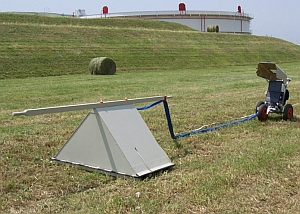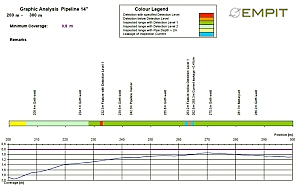EMPIT inspection of unpiggable pipelines
The EMPIT technique performs a non-destructive testing method for unpi ggable pipelines, using above ground measurements for detecting anomalies in wall thickness, for example corrosion. The method was developed in the late nineties for inspection of unpiggable, difficult to pig pipelines or pipeline sections not suitable for inline inspection. Since then, EMPIT inspection method has been used by many pipeline operators across the world and is approved by independent technical authorities, such as PRCI, DOT, or TÜV SÜD.
ggable pipelines, using above ground measurements for detecting anomalies in wall thickness, for example corrosion. The method was developed in the late nineties for inspection of unpiggable, difficult to pig pipelines or pipeline sections not suitable for inline inspection. Since then, EMPIT inspection method has been used by many pipeline operators across the world and is approved by independent technical authorities, such as PRCI, DOT, or TÜV SÜD.
EMPIT inspection method has been introduced in Slovakia in 2007, and so far, it has been used to measure sections of older pipelines operated by NAFTA, a.s., or sections of oil pipeline operated by TRANSPETROL, a.s., followed by a verification and evaluation of all findings.
During the EMPIT inspection the pipeline remains online, fully operational and no restrictions are necessary regardless of the type, pressure or temperature of the transported medium.
The EMPIT method is used to:
– Identify metal loss defects in the pipeline wall (corrosion, mill features, gouges, dents or lacking material in the girth weld layers)
– Localise pipeline coating defects, based on the leakage of inspecting current
– accurate measurement of pipeline coverage, vertical and horizontal configuration of pipeline.
The EMPIT method is suitable for:
– measurement of operating unpiggable pipelines, or near the end of its design life.
– condition assessment of certain sections of high-pressure pipeline systems in the so-called High Consequence Areas
– verification of actual pipeline vertical and horizontal configuration, approximate bend radius and coverage.
– measurement of pipeline sections in casings.
– Detection of other pipelines crossing the measured pipeline, localisation of other metal objects in close proximity to the measured pipeline.
– verification of coating defects found by the DCVG coating inspection method (potential measurement).
Technical specifications of the EMPIT method
| Nominal pipeline diameter: | DN80 – DN1200 |
| Pipeline wall thickness: | Up to 15 mm |
| Material loss (depends on pipeline specification): | At least 20% wall thickness |
| Pipeline inspection current: | 16 A |
| Length of inspection between two contacting points: | 1000 m |
| Inspection length per day: | 800 m |
| Depth of pipe (to its axis): | up to 2,0 m |
| Depth resolution: | +/- 20 mm |
| Defect specifications (for POD > 96%): | |
| Minimal length: | 50 mm |
| Minimal width: | 50 mm |
| Peak depth: | Min. 50% wall thickness |
| Defect detection (response threshold): | >25% metal loss |
